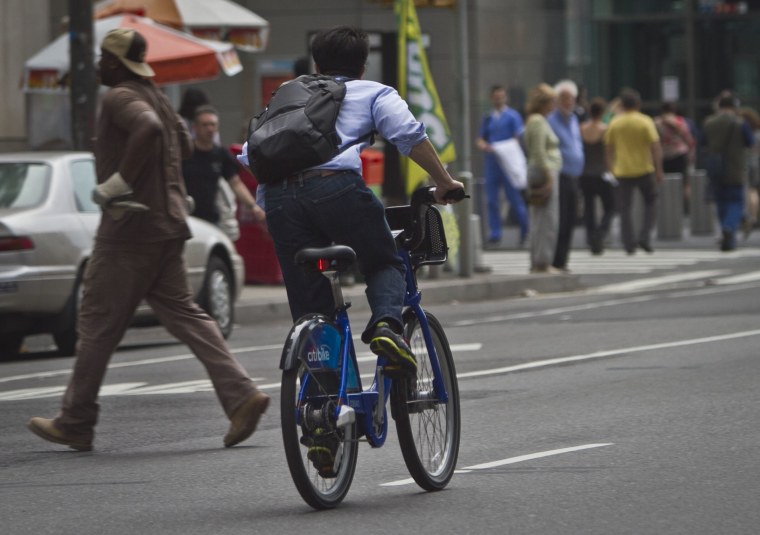In a city where the mayor is often portrayed as a protective nanny, restricting cigarettes, fatty foods and sugary drinks, there is a glaring exception: a new bike-share program that allows riders to pedal through some of the nation's busiest streets without a helmet.
The lack of a helmet requirement in New York's month-old Citi Bike program, which eventually will accommodate as many as 10,000 cyclists — many of them tourists — has some experts predicting a disastrous increase in injuries and fatalities. Comedians have piled on, with "The Daily Show" host Jon Stewart sarcastically suggesting a "Street Brain Material Removal Service."
But so far, through more than 500,000 rides, such predictions haven't come true, with just three minor accidents and nothing more serious than some scrapes and bruises.
When asked about the rationale for not requiring helmets, city officials repeated what they have said for months — that such a mandate would be impractical to enforce.
The reason, experts say, is that helmet requirements tends to dampen the popularity of bike-share programs by taking the spontaneity out of the decision to just hop on a bike and go.
New York City's privately financed program — called Citi Bike, after lead sponsor Citigroup Inc. — was a pet policy goal of Mayor Michael Bloomberg as a way to decrease the number of drivers on the road and encourage healthy lifestyles. It began late last month with 6,000 bikes at 330 docking stations, with plans to expand eventually to 10,000 bikes and 600 stations.
Riders can unlock the three-gear, cruising-style bikes from any station, take them for 45-minute rides and return them to any rack. Thousands of people have already signed up for $95 annual memberships for unlimited rides. A 24-hour pass costs about $10. Any profits will be split between the private operator and the city.
Despite the fact the city has laid down 300 miles of new bike lanes in the last five years, cycling in New York is still a proceed-at-your-own-risk pastime.
Speeding cabs, fume-belching buses, honking drivers and texting pedestrians turn even short rides into obstacle courses. Bike lanes blocked by parked cars, delivery trucks and even police cruisers have become another frequent source of aggravation, forcing cyclists into the thick of traffic.
A 2009 study found that New York's bike lanes are blocked more often than not — during a 10-minute span, a cyclist has a 60 percent chance of being blocked by a car, truck or taxi.
Bloomberg spokesman John McCarthy defended the city's bike friendliness, saying the most effective way to keep cyclists safe is separating cyclists from drivers, "which we have done more in this city than any other city in America."
A lack of a helmet requirement, blocked bike lanes and inexperienced cyclists hitting the road are all reasons Rutgers University public policy professor John Pucher cited in predicting that the number of cyclist injuries and fatalities will double or even triple in Citi Bike's first year.
But there is also research supporting the theory that bike-share schemes calm traffic because drivers are more cautious when cyclists are on the road.
The Mineta Transportation Institute in California studied 14 bike-share programs and found relatively low accident rates, averaging 1.36 serious or fatal accidents in 2011. In the same year, there were 22 fatalities for bicyclists in New York.
Dan Taeyoung, an architect, was putting his faith in that theory as he unlocked a bright blue Citi Bike and prepared to venture out helmetless at Columbus Circle.
"I normally wear a helmet, but these bikes are strong, visible, stable," he said. "And the more bikes there are, the more drivers have to pay attention."
